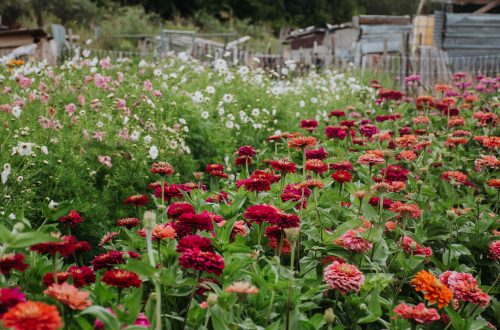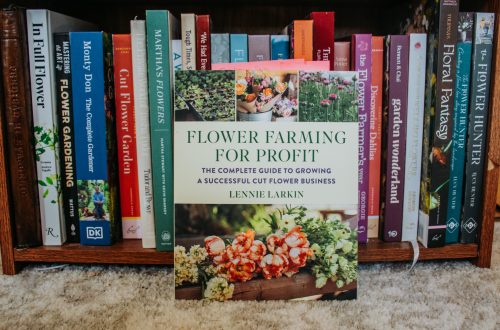
This is part two of a five-part series all about how to start a small flower farm. If you haven’t already, make sure you check out part one about formulating a business plan and choosing your planting sites first, which you can find HERE.
Note: There are affiliate links to the books and products mentioned in the series.
Deciding What to Plant
So you’ve selected your farm site, decided roughly how many square feet to plant, and decided on a business strategy. Now comes the fun part — deciding what to plant!
Now, it is imperative that you have a firm business plan (including your target customer/audience and marketing strategy) in place BEFORE you drop a single penny on seeds and plants. Why? Because what you plant is entirely determined by what and whom you’re planting FOR.
If you’re planning on selling to florists and wholesalers, you need to plant a high volume of the same kind of flower in the same color. It also might be good to specialize in a high value crop, such as garden roses, peonies, lisianthus, ranunculus, or dahlias. Additionally, you’ll need to be consulting color trends for whatever events (such as weddings) your florist or wholesaler will be most likely to supply. Another way to approach selling to florists is to grow primarily things that can’t be shipped over long distances, such as zinnias, ornamental basil, celosia, cosmos, or sweet peas.
If you’re planning on offering a bouquet subscription service (especially one that goes over your whole growing season), you’ll need to focus your attention on growing a wide variety of focal flowers, filler, and foliage, and you’ll need to carefully plan out your crops so that you have things in bloom throughout your entire growing season (which means you’ll definitely need to plant backups, and backups of your backups).
If you’re only planning on selling at a farmer’s market in late summer, then you only need to worry about planting summer crops, and doing multiple successions of them.
If you really have no idea which direction you want your business to go, pick the two you’re most likely to start with and go from there. However, unless you’re exclusively just selling a few select crops to florists or wholesalers, chances are high that you’ll need to grow a decently wide variety of flowers and plants that fall into the following categories: focals, spikes, filler flowers, foliage, and textural elements.
Why those categories?
Because those are the five elements you need to create a killer bouquet or arrangement.
Most beginning flower farmers only focus on the first one or two categories (the focals and maybe the spikes), and they completely ignore the rest. As a result, their bouquets LOOK beginner/amateur-ish, and they won’t be as likely to sell a lot of them.
Planning out plants from each category for each season takes a lot of work and a lot of planning, but having elements from all five categories means that you’ll be able to put together fabulous arrangements no matter where you’re at in your growing season.
Below, I’ll detail some of my favorites for each category, grouped together by season.

Focals
Focal flowers are the attention-grabbers — they’re often the whole reason people stop and even consider buying flowers from you. Without a big, punchy bloom to draw in the eye, you probably won’t sell much. Luckily, each season comes with its own stunning focal flowers in a wide range of colors and styles.
Again, it is essential that you have backup crops in case your main focal flower crop fails. For example, this last spring I was highly counting on my tulips to pull a lot of the weight for my focals over about a 6-week period. Unfortunately, I suffered a massive crop loss. However, because I’d learned from my mistakes the previous year with having flowers not come on during their expected bloom times, I’d planted backups in my own backyard flower farm as well as planned backups through generous neighbors who had an abundance of certain flowers in their yards that they were willing to let me have, so even though the crop loss was disappointing, business could still go on.
Below are some favorite focal flowers for each period of the growing season:
- Early Spring: daffodils, tulips, hyacinths
- Late Spring: peonies, irises, ranunculus
- Summer: lilies, sunflowers, lisianthus, zinnias
- Autumn: dahlias, rudbeckia
Spikes
Spikes are anything that provides a vertical line in an arrangement. Often that will take the form of stems that have multiple flowers that blossom up a stem from the bottom, but sometimes it takes the form of interesting branches, too.
- Spring: larkspur, pussy willow branches, bellflower, stock
- Summer: snapdragons, anise hyssop
- Autumn: orach, gladiolus

Filler Flowers
Filler flowers take many different forms: sometimes they’re the “froth” of an arrangement–as in the case of ammi or feverfew–and sometimes they’re just smaller, more secondary flowers that complement and enhance the look of your focal flowers.
- Spring: lilacs, clover, alfalfa, bachelor’s buttons, spirea
- Late Spring: alliums, sweet william, daisies, ammi
- Summer: ageratum, balm (all types), feverfew (my absolute favorite), statice, annual phlox, gomphrena, yarrow
- Autumn: celosia, china asters, rudbeckia triloba, fennel
Foliage + Greenery
I cannot overstate the importance of having foliage and greenery in your arrangements. In my opinion, most arrangements that skimp or skip out entirely on foliage and greenery will nearly always have a more amateur look about them, and they also will feel like they “need” more flowers simply because they lack the bulk and background that good foliage provides.
I personally plan to add a lot more shrubs to our flower farm in order to give myself more options (I’m looking specifically into several different types of ninebark as well as lady’s mantle), but the ones below are the ones that I’ve tried already and that I use regularly.
Each one of these has become an absolute staple for me, and I’d find any single one of them hard to live without.
- Spring: raspberry greens, artemisia, tulip leaves
- Summer: basil (lemon, cinnamon), euphorbia, Aurelia’s verde amaranth or other green amaranth, mint, honeywort
- Autumn: mahogany splendor hibiscus, red spike amaranth, hot biscuits amaranth, Hopi red dye amaranth, amoratto basil, goldenrod
Textural Elements
If you have all the elements above, your bouquets will usually look lush and full and definitely like something people would want to buy. But if you’re able to add an airy, textural element that kind of floats above all the rest? Pure magic. For me, it’s these textural, whimsical pieces that almost always deliver the final WOW factor.
- Spring: cress, saponaria, bleeding heart
- Summer: frosted explosion grass (my favorite!), annual baby’s breath
- Autumn: bunny tail grass, jewels of opar (talinum)

Other Considerations
Climate
I live in an arid, hot climate that is almost always suffering some kind of drought and where temperatures range from below zero in the winter to over 100 degrees in the summer. Our spring is generally a flash in the pan, and we definitely live in extreme temperatures for many months out of the year.
As such, I tend to struggle with some hardy annuals and other such plants that prefer mild, temperate conditions. The things that usually grow best for me are heat-loving and drought tolerant, although I have been able to grow some things successfully here that generally don’t love our climate simply by planting in part shade or using 50%-strength shade cloth (such as this).
While you can definitely try to grow whatever you’re drawn the most to, you’ll generally have the best success if you stick with plants that naturally do well in your climate. That may take some trial and error, but it’s worth working with what you have rather than moaning over what you don’t.
Fragrance
Fragrance wasn’t a huge consideration for me at first, but it’s become much more so now. I noticed immediately how often people would comment whenever I put in flowers or stems that were fragrant, and how much delight it seemed to bring to my customers. Nowadays, I try to never let a bouquet or arrangement leave my farm that doesn’t have at least one fragrant piece in it.
In fact, sometimes I’ll put in certain things simply for the fragrance alone, not because I necessarily love the look or texture of that particular thing.
Spring tends to have the most fragrant blooms naturally, such as peonies, daffodils, hyacinths, and lilacs. Once you get into high summer, however, you need to be a bit more intentional.
My favorite ingredient to use for fragrance in late spring and early summer is stock, and my favorite fragrant stem to use in summer and autumn is lemon or cinnamon basil. Sometimes I’ll slip in a fragrant rosebud, not because it will last as long as my bouquets usually do, but for the smell alone. It seems like a side note kind of thing, but people pretty much ALWAYS notice fragrance, and it can really make a big difference when it comes to the whole “experience” of your flowers.

Planning Your Year
The ideal time to start planting and such for a new flower farm is actually around October, when you’ll be putting in bulbs for spring, such as tulips, hyacinths, and daffodils. The next best time is wherever you happen to be now 🙂
Basically, no matter the season of the year you are currently in, there is something you can do to further your flower farming dream. Sure, you might not be able to have a whole growing season to realize all your dreams ASAP (not that that’s realistic, anyway), but whatever growing and harvesting and researching you can do right where you’re at will only serve to help you down the road.
Here’s a rundown of the general “arc” of our flower farming year, starting in late autumn, after a few frosts:
October/November: Plant all your spring bulbs, tear out dead plants and tidy up beds, add thick layer of mulch to everything to break down over the winter and enrich the soil, prune existing roses or shrubs. If you have a high tunnel, plant ranunculus and anemone corms or whatever you choose to try and overwinter.
December/January: Plan out your planting schedule, order seeds, start super slow-growing seeds like lisianthus or eucalyptus inside.
February/March: Start your first wave of hardy annuals, starting with the slowest to grow first (like snapdragons and rudbeckia). Note: If you haven’t purchased the book Cool Flowers by Lisa Mason Ziegler, which is all about hardy annuals, it is hands-down an absolute must-own for any flower farmer. Start prepping any beds outside (tearing out dead plants, adding compost, sending in soil samples to be tested) as the weather permits.
April/May: Start your first successions of tender annuals and start hardening and transplanting out your hardy annuals. After your last frost, plant out everything else. Harvest spring crops.
June/July: Keep succession planting to ensure you have a steady crop throughout your season. Start the hardy annual and biennial seeds you hope to overwinter for next year. Harvest late spring and summer crops to keep the blooms coming.
August: Try to stay on top of the weeding and harvesting the best you can. Do your best not to burn out 😉
September: Start ripping plants out once they’re spent and prepare beds to plant crops that will be overwintered. Transplant or direct sow hardy annuals and biennials for next year.
If you want a few more resources that help further break down a year in flower farming, check out The Flower Farmer’s Year by Georgie Newbery, A Year in Flowers by Erin Benzakein, and A Year Full of Flowers by Sarah Raven.
Drop a comment below with your favorite flowers to grow, as well as any questions you might have!







